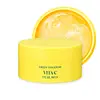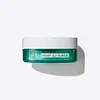What's inside
What's inside
 Key Ingredients
Key Ingredients

 Benefits
Benefits

 Concerns
Concerns

 Ingredients Side-by-side
Ingredients Side-by-side

Water
Skin ConditioningGlycerin
HumectantNiacinamide
SmoothingCarrageenan
1,2-Hexanediol
Skin ConditioningCeratonia Siliqua Gum
EmollientHydroxyacetophenone
AntioxidantGlucomannan
Skin ConditioningCalcium Chloride
AstringentChlorphenesin
AntimicrobialAllantoin
Skin ConditioningPropanediol
SolventChondrus Crispus
MaskingCyamopsis Tetragonoloba Gum
Emulsion StabilisingChondrus Crispus Powder
AbrasivePolyglyceryl-10 Laurate
Skin ConditioningPotassium Chloride
Pentylene Glycol
Skin ConditioningSucrose
HumectantPinus Sylvestris Leaf Extract
TonicAdenosine
Skin ConditioningEthylhexylglycerin
Skin ConditioningDipotassium Glycyrrhizate
HumectantDisodium EDTA
Melia Azadirachta Flower Extract
Skin ConditioningCocos Nucifera Fruit Extract
EmollientCitrus Aurantium Bergamia Fruit Oil
MaskingCitrus Tangerina Extract
TonicMelia Azadirachta Leaf Extract
Skin ConditioningAscorbyl Glucoside
AntioxidantCurcuma Longa Root Extract
MaskingOcimum Sanctum Leaf Extract
Skin ConditioningButylene Glycol
HumectantCorallina Officinalis Extract
Skin ConditioningCitrus Limon Peel Oil
MaskingCalcium Lactate
AstringentArbutin
AntioxidantLavandula Angustifolia Oil
MaskingCananga Odorata Flower Oil
MaskingCitrus Aurantium Dulcis Peel Oil
MaskingEucalyptus Globulus Leaf Extract
PerfumingTocopherol
AntioxidantPotassium Hydroxide
BufferingHyaluronic Acid
HumectantHydrolyzed Hyaluronic Acid
HumectantSodium Hyaluronate
HumectantLimonene
PerfumingLinalool
PerfumingWater, Glycerin, Niacinamide, Carrageenan, 1,2-Hexanediol, Ceratonia Siliqua Gum, Hydroxyacetophenone, Glucomannan, Calcium Chloride, Chlorphenesin, Allantoin, Propanediol, Chondrus Crispus, Cyamopsis Tetragonoloba Gum, Chondrus Crispus Powder, Polyglyceryl-10 Laurate, Potassium Chloride, Pentylene Glycol, Sucrose, Pinus Sylvestris Leaf Extract, Adenosine, Ethylhexylglycerin, Dipotassium Glycyrrhizate, Disodium EDTA, Melia Azadirachta Flower Extract, Cocos Nucifera Fruit Extract, Citrus Aurantium Bergamia Fruit Oil, Citrus Tangerina Extract, Melia Azadirachta Leaf Extract, Ascorbyl Glucoside, Curcuma Longa Root Extract, Ocimum Sanctum Leaf Extract, Butylene Glycol, Corallina Officinalis Extract, Citrus Limon Peel Oil, Calcium Lactate, Arbutin, Lavandula Angustifolia Oil, Cananga Odorata Flower Oil, Citrus Aurantium Dulcis Peel Oil, Eucalyptus Globulus Leaf Extract, Tocopherol, Potassium Hydroxide, Hyaluronic Acid, Hydrolyzed Hyaluronic Acid, Sodium Hyaluronate, Limonene, Linalool
Water
Skin ConditioningGlycerin
HumectantMethylpropanediol
SolventChondrus Crispus Extract
Skin ConditioningCeratonia Siliqua Gum
EmollientSoluble Collagen
HumectantSodium Hyaluronate
HumectantSodium Acetylated Hyaluronate
HumectantHydrolyzed Hyaluronic Acid
HumectantDiamond Powder
AbrasivePolyglutamic Acid
Skin ConditioningTremella Fuciformis Sporocarp Extract
AntioxidantXanthan Gum
EmulsifyingCellulose Gum
Emulsion StabilisingAllantoin
Skin ConditioningPotassium Chloride
Sucrose
HumectantPEG-60 Hydrogenated Castor Oil
EmulsifyingBenzophenone-5
UV AbsorberDisodium EDTA
1,2-Hexanediol
Skin ConditioningHydroxyacetophenone
AntioxidantGlyceryl Caprylate
EmollientCI 77891
Cosmetic ColorantCI 42090
Cosmetic ColorantCI 19140
Cosmetic ColorantWater, Glycerin, Methylpropanediol, Chondrus Crispus Extract, Ceratonia Siliqua Gum, Soluble Collagen, Sodium Hyaluronate, Sodium Acetylated Hyaluronate, Hydrolyzed Hyaluronic Acid, Diamond Powder, Polyglutamic Acid, Tremella Fuciformis Sporocarp Extract, Xanthan Gum, Cellulose Gum, Allantoin, Potassium Chloride, Sucrose, PEG-60 Hydrogenated Castor Oil, Benzophenone-5, Disodium EDTA, 1,2-Hexanediol, Hydroxyacetophenone, Glyceryl Caprylate, CI 77891, CI 42090, CI 19140
Ingredients Explained
These ingredients are found in both products.
Ingredients higher up in an ingredient list are typically present in a larger amount.
1,2-Hexanediol is a synthetic liquid and another multi-functional powerhouse.
It is a:
- Humectant, drawing moisture into the skin
- Emollient, helping to soften skin
- Solvent, dispersing and stabilizing formulas
- Preservative booster, enhancing the antimicrobial activity of other preservatives
Allantoin is a soothing ingredient known for its protective and moisturizingg properties. Because of this, it is often added to products with strong active ingredients.
Studies show higher concentrations of this ingredient can promote wound healing.
Though it can be derived from the comfrey plant, allantoin is produced synthetically for cosmetic products to ensure purity.
Learn more about AllantoinCeratonia Siliqua Gum is extracted from the seeds of the carob tree. You might know this ingredient as Carob Gum or Locust Bean Gum. It is used to stabilize other ingredients and improve the texture of products.
Carob gum is made up of long-chain polysaccharides. This makes it a natural thickener.
Yes! This ingredient comes from the seeds of a tree. The name 'Locust Bean Gum' can be misleading.
Learn more about Ceratonia Siliqua GumDisodium EDTA plays a role in making products more stable by aiding other preservatives.
It is a chelating agent, meaning it neutralizes metal ions that may be found in a product.
Disodium EDTA is a salt of edetic acid and is found to be safe in cosmetic ingredients.
Learn more about Disodium EDTAGlycerin is already naturally found in your skin. It helps moisturize and protect your skin.
A study from 2016 found glycerin to be more effective as a humectant than AHAs and hyaluronic acid.
As a humectant, it helps the skin stay hydrated by pulling moisture to your skin. The low molecular weight of glycerin allows it to pull moisture into the deeper layers of your skin.
Hydrated skin improves your skin barrier; Your skin barrier helps protect against irritants and bacteria.
Glycerin has also been found to have antimicrobial and antiviral properties. Due to these properties, glycerin is often used in wound and burn treatments.
In cosmetics, glycerin is usually derived from plants such as soybean or palm. However, it can also be sourced from animals, such as tallow or animal fat.
This ingredient is organic, colorless, odorless, and non-toxic.
Glycerin is the name for this ingredient in American English. British English uses Glycerol/Glycerine.
Learn more about GlycerinHydrolyzed Hyaluronic Acid is a form of hyaluronic acid. It is created by the hydrolysis of hyaluronic acid with a high molecular weight. Once created, Hydrolyzed Hyaluronic Acid has a low molecular weight.
Low molecular weight HA has been shown to hydrate and increase elasticity of the skin. Increasing elasticity is also associated with reduction of wrinkle depth.
One study found topical low molecular weight hyaluronic acid may be considered for the treatment of rosacea in the adult population. However, we always recommend speaking with a professional about your skin concerns.
Hyaluronic acids are a humectant. This means they draw moisture from the air. Hyaluronic acids help moisturize, soothe, and protect the skin.
Read more about other common forms of hyaluronic acid:
Learn more about Hydrolyzed Hyaluronic AcidHydroxyacetophenone is antioxidant with skin conditioning and soothing properties. It also boosts the efficiency of preservatives.
This ingredient is not irritating or sensitizing.
Potassium Chloride can be bad for oily skin and be bad for acne prone skin.
Sodium Hyaluronate is hyaluronic acid's salt form. It is commonly derived from the sodium salt of hyaluronic acid.
Like hyaluronic acid, it is great at holding water and acts as a humectant. This makes it a great skin hydrating ingredient.
Sodium Hyaluronate is naturally occurring in our bodies and is mostly found in eye fluid and joints.
These are some other common types of Hyaluronic Acid:
Learn more about Sodium HyaluronateSucrose is a natural sugar found in fruits, vegetables, and nuts. It is the main constituent of white sugar.
In skincare, sucrose is a humectant and can be a mild exfoliant.
Sucrose is hydrophilic, meaning it attracts water. This makes it an effective humectant and helps hydrate the skin.
Studies show sugars may worsen acne-prone skin due to it disrupting the skin's natural biome. We recommend speaking with a professional if you have any concerns.
In some products such as body scrubs, sucrose is used as an gentle exfoliant.
The term 'sucrose' comes from the french word for sugar, 'sucre'.
Learn more about SucroseWater. It's the most common cosmetic ingredient of all. You'll usually see it at the top of ingredient lists, meaning that it makes up the largest part of the product.
So why is it so popular? Water most often acts as a solvent - this means that it helps dissolve other ingredients into the formulation.
You'll also recognize water as that liquid we all need to stay alive. If you see this, drink a glass of water. Stay hydrated!
Learn more about Water